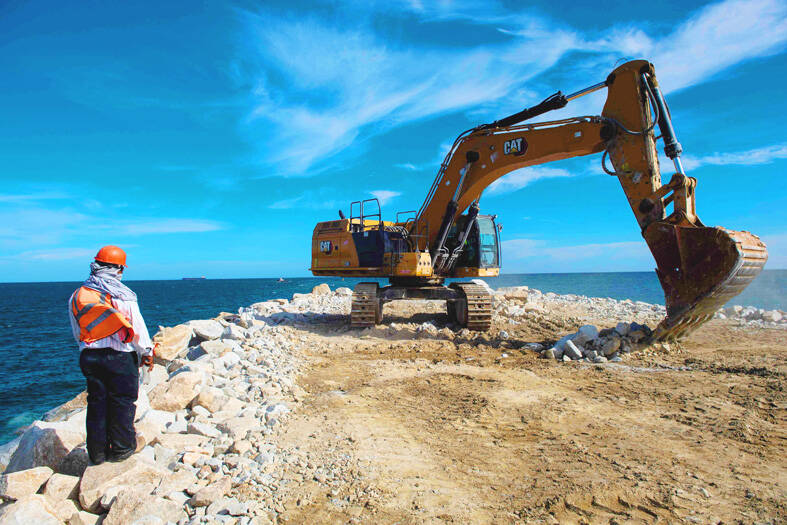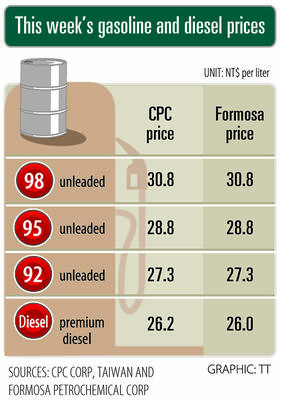At Mexico’s narrowest point, linking the Pacific and Atlantic oceans, the government is building a railway rival to the Panama Canal with promises of economic bounty, but amid fears of environmental and social harm.
The Spanish conquistador Hernan Cortes already dreamed of such a crossing for humans and goods in the 16th century, but most plans came to naught and a prior, rudimentary connection was all but abandoned with the opening of the canal cutting through Panama in 1914.
Then, in 2020, work started on a new coast-to-coast link under the government of Mexican President Andres Manuel Lopez Obrador.

Photo: AFP
It comprises a 300km railway line from the Pacific port of Salina Cruz to Coatzacoalcos on the other side of the Isthmus of Tehuantepec — a region rich in biodiversity and Indigenous heritage.
The government has announced an investment of US$2.85 billion.
Project coordinator Adiel Estrada said it has created 800 direct jobs and about 2,400 indirect ones — a much-needed injection for that part of the country.
Officials expect that once fully operational, by 2033, the “interoceanic corridor” would boost GDP by 3 to 5 percentage points.
“We will go ... from one ocean to the other in seven hours,” Lopez Obrador boasted of the project in a recent video recorded aboard a brand-new train.
Service is expected to start in December with two daily round-trips for passengers, and three for cargo.
By 2028, the Isthmus of Tehuantepec Interoceanic Corridor (CIIT) should have 300,000 cargo containers transiting every year, with 1.4 million by 2033. The 80km Panama Canal moved about 63.2 million tons last year.
Lopez Obrador has said the CIIT comes at a time that “our brothers in Panama are having difficulties due to water shortages” in the canal through which three percent of global maritime trade passes.
The Panama Canal Authority has had to reduce traffic to 25 ships per day starting Nov. 3 — down from 39 per day on average last year. By mid-February it would be down to 20 per day.
The Mexican corridor would be accompanied by the development of industrial parks, which the government hopes will attract about US$7 billion in investment.
However, the corridor has had a mixed response.
“It’s a magnificent project,” said Angelica Gonzalez, a 42-year-old craftswoman from Ciudad Ixtepec, one of the stops on the new route she hopes will boost sales to tourists.
Gonzalez was five years old when she last took a passenger train linking the two coasts.
That line was fully operational from 1907 to the 1950s, then declined until the 1990s when it finally closed, leaving only one cargo train on the route.
The cargo service has long been in urgent need of an update as Mexico upgrades capacity at its Atlantic and Pacific ports and the CIIT is meant to do just that.
Salina Cruz green activist Rafael Mayoral said that people along the route are “very motivated” for its opening.
Yet he said that “does not erase its environmental and social impact.”
According to another activist, Juana Ramirez of the Union of Indigenous Communities in the Northern Zone of the Isthmus (UCIZONI) non-governmental organization, the isthmus was likely to become polluted and downgraded by the project, with trees felled and vegetation uprooted.
The UCIZONI says communities were not adequately consulted on the project, and that several people have been displaced.
Ramirez said locals were being “harassed.”
She herself faces a large fine — yet to be determined by a court — for taking part in a protest against the CIIT.
Activists also fear a rise of violence in the area with organized crime likely to grow as access improves.
By the middle of next year, the train is meant to link up to another line to the border with Guatemala via Mexico’s Chiapas state — a gateway for US-bound migrants without travel documents who frequently fall victim to smuggling gangs.
Observers also say that gangs are seizing land near the railway lines — uprooting residents — as they expect its value to rise.
The Mexican Center for Environmental Law non-governmental organization recorded three murders of land activists between October last year and July that it said were linked to the corridor.

Taiwan Semiconductor Manufacturing Co (TSMC, 台積電), the world’s biggest contract chipmaker, booked its first-ever profit from its Arizona subsidiary in the first half of this year, four years after operations began, a company financial statement showed. Wholly owned by TSMC, the Arizona unit contributed NT$4.52 billion (US$150.1 million) in net profit, compared with a loss of NT$4.34 billion a year earlier, the statement showed. The company attributed the turnaround to strong market demand and high factory utilization. The Arizona unit counts Apple Inc, Nvidia Corp and Advanced Micro Devices Inc among its major customers. The firm’s first fab in Arizona began high-volume production

VOTE OF CONFIDENCE: The Japanese company is adding Intel to an investment portfolio that includes artificial intelligence linchpins Nvidia Corp and TSMC Softbank Group Corp agreed to buy US$2 billion of Intel Corp stock, a surprise deal to shore up a struggling US name while boosting its own chip ambitions. The Japanese company, which is adding Intel to an investment portfolio that includes artificial intelligence (AI) linchpins Nvidia Corp and Taiwan Semiconductor Manufacturing Co (TSMC, 台積電), is to pay US$23 a share — a small discount to Intel’s last close. Shares of the US chipmaker, which would issue new stock to Softbank, surged more than 5 percent in after-hours trading. Softbank’s stock fell as much as 5.4 percent on Tuesday in Tokyo, its

The prices of gasoline and diesel at domestic fuel stations are to rise NT$0.1 and NT$0.4 per liter this week respectively, after international crude oil prices rose last week, CPC Corp, Taiwan (台灣中油) and Formosa Petrochemical Corp (台塑石化) announced yesterday. Effective today, gasoline prices at CPC and Formosa stations are to rise to NT$27.3, NT$28.8 and NT$30.8 per liter for 92, 95 and 98-octane unleaded gasoline respectively, the companies said in separate statements. The price of premium diesel is to rise to NT$26.2 per liter at CPC stations and NT$26 at Formosa pumps, they said. The announcements came after international crude oil prices

SETBACK: Apple’s India iPhone push has been disrupted after Foxconn recalled hundreds of Chinese engineers, amid Beijing’s attempts to curb tech transfers Apple Inc assembly partner Hon Hai Precision Industry Co (鴻海精密), also known internationally as Foxconn Technology Group (富士康科技集團), has recalled about 300 Chinese engineers from a factory in India, the latest setback for the iPhone maker’s push to rapidly expand in the country. The extraction of Chinese workers from the factory of Yuzhan Technology (India) Private Ltd, a Hon Hai component unit, in southern Tamil Nadu state, is the second such move in a few months. The company has started flying in Taiwanese engineers to replace staff leaving, people familiar with the matter said, asking not to be named, as the